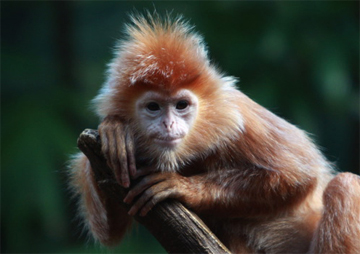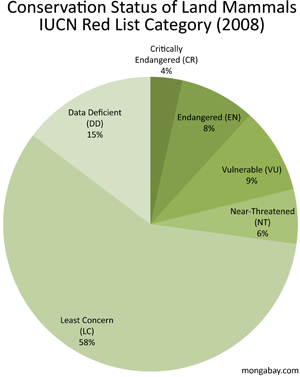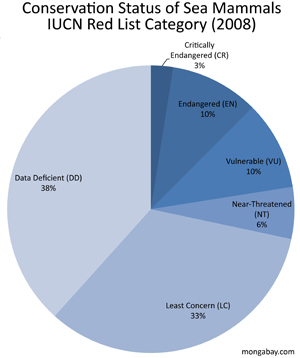Half of the world’s mammal species in decline
mongabay.com
October 6, 2008
Half of the world’s mammal species are in decline, according to a new assessment of the planet’s 5,487 mammals.
The survey, led by IUCN and conducted by more than 1700 experts in 130 countries, reports that at least 21 percent of mammals are at risk of extinction, while 52 percent of species are experience declining population trends. 76 species are known to have gone extinct since 1500 while another 29 haven’t been seen in years.
79 percent of primate species in South and Southeast Asia are threatened and all of the world’s ape — mankind’s closest relatives — face risks.
|
|
“Within our lifetime hundreds of species could be lost as a result of our own actions, a frightening sign of what is happening to the ecosystems where they live,” said Julia Marton-Lefévre, IUCN Director General. “We must now set clear targets for the future to reverse this trend to ensure that our enduring legacy is not to wipe out many of our closest relatives.”
The IUCN Red List, which serves as the official roster of the world’s endangered species, is updated on a periodic basis. Earlier revisions for amphibians and corals offered a dire outlook for global biodiversity, a trend continued in the mammal update. The Red List currently includes a total of 44,838 species.
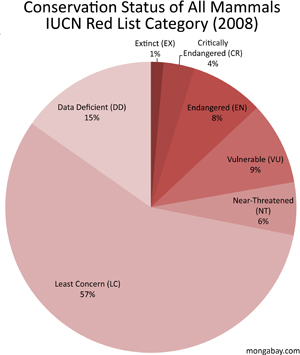
Click images to enlarge |
IUCN says the list is compiled to help prioritize conservation efforts for species and ecosystems. Still the conservation status of 15 percent of mammal species is unknown due to insufficient data.
“The reality is that the number of threatened mammals could be as high as 36 percent,” explained Jan Schipper, a researcher at Conservation International who was lead author of the upcoming Science article that presents the results of the assessment. “This indicates that conservation action backed by research is a clear priority for the future, not only to improve the data so that we can evaluate threats to these poorly known species, but to investigate means to recover threatened species and populations.”
Threats to species vary between habitat, geography, and mammal group, but generally land species are most imperilled by habitat loss and over-exploitation as food and traditional medicine. Marine species face the greatest risk from pollution and accidental death from boat collisions and as by-catch of the fishing industry. Threatened species are concentrated in South and Southeast Asia where large swathes of habitat have been converted for agriculture and hunting pressure is high and in regions where there are elevated levels of biodiversity but rapid change in forest cover, including the tropical Andes in South America, the Cameroonian Highlands in West Africa, Albertine Rift in East Africa, and Western Ghats in India.
“Our results paint a bleak picture of the global status of mammals worldwide,” the authors write.
The updated Red List was presented Monday at the IUCN World Conservation Congress in Barcelona. More than 8,000 conservationists, policy-makers, business leaders, and researchers are expected to attend the 10-day meeting.
Earlier article
One quarter to one third of mammals threatened with extinction: One in four of the world’s land mammal species and one in three marine mammal species is threatened with extinction, according to an update of the IUCN Red List. The five-year assessment by more than 1700 experts in 130 countries compiled detailed information on taxonomy, distribution, habitats, population trends, and conservation status of, as well as threats to, the world’s 5,487 mammal species. The results show that 21 to 36 percent of mammals are at risk of extinction, while 76 mammals species are known to have gone extinct since 1500 and another two species have disappeared in the wild.
Countries with most recorded threatened species
| Country | Extinct | Threatened | Total Assessed Species |
% Threatened | ||||
| United States | 233 | 948 | 3,394 | 27.9% | ||||
| Australia | 40 | 733 | 2,698 | 27.2% | ||||
| Indonesia | 1 | 701 | 3,682 | 19.0% | ||||
| Mexico | 28 | 636 | 3,122 | 20.4% | ||||
| Malaysia | 0 | 455 | 2,122 | 21.4% | ||||
| Colombia | 3 | 429 | 3,298 | 13.0% | ||||
| Philippines | 0 | 425 | 1,713 | 24.8% | ||||
| India | 1 | 413 | 2,530 | 16.3% | ||||
| China | 5 | 370 | 2,707 | 13.7% | ||||
| Ecuador | 6 | 369 | 2,644 | 14.0% | ||||
| Thailand | 2 | 357 | 2,200 | 16.2% | ||||
| Brazil | 10 | 356 | 3,453 | 10.3% | ||||
| Madagascar | 10 | 355 | 1,392 | 25.5% | ||||
| Tanzania | 38 | 349 | 2,872 | 12.2% | ||||
| South Africa | 5 | 324 | 1,946 | 16.6% | ||||
| Papua New Guinea | 1 | 304 | 2,035 | 14.9% | ||||
| Japan | 13 | 297 | 1,498 | 19.8% | ||||
| Viet Nam | 0 | 261 | 1,866 | 14.0% | ||||
| Peru | 3 | 261 | 2,818 | 9.3% | ||||
| Sri Lanka | 21 | 254 | 1,086 | 23.4% |
Countries with most recorded extinct species
| Country | Extinct | Threatened | Total Assessed Species |
% Threatened | ||||
| United States | 233 | 948 | 3,394 | 27.9% | ||||
| French Polynesia | 79 | 102 | 456 | 22.4% | ||||
| Australia | 40 | 733 | 2,698 | 27.2% | ||||
| Mauritius | 40 | 131 | 580 | 22.6% | ||||
| Tanzania | 38 | 349 | 2,872 | 12.2% | ||||
| Kenya | 38 | 208 | 2,259 | 9.2% | ||||
| Uganda | 38 | 121 | 1,788 | 6.8% | ||||
| Saint Helena | 29 | 34 | 131 | 26.0% | ||||
| Mexico | 28 | 636 | 3,122 | 20.4% | ||||
| Sri Lanka | 21 | 254 | 1,086 | 23.4% | ||||
| New Zealand | 19 | 122 | 421 | 29.0% | ||||
| Réunion | 16 | 89 | 474 | 18.8% | ||||
| Cook Islands | 15 | 49 | 299 | 16.4% | ||||
| Japan | 13 | 297 | 1,498 | 19.8% | ||||
| Brazil | 10 | 356 | 3,453 | 10.3% | ||||
| Madagascar | 10 | 355 | 1,392 | 25.5% | ||||
| Haiti | 10 | 101 | 488 | 20.7% | ||||
| Norfolk Island | 10 | 40 | 150 | 26.7% | ||||
| Dominican Republic | 9 | 94 | 474 | 19.8% | ||||
| Martinique | 8 | 23 | 288 | 8.0% |
Countries with high proportion of threatened species (minimum of 300 species assessed)
| Country | Extinct | Threatened | Total Assessed Species |
% Threatened | ||||
| New Zealand | 19 | 122 | 421 | 29.0% | ||||
| United States | 233 | 948 | 3,394 | 27.9% | ||||
| Australia | 40 | 733 | 2,698 | 27.2% | ||||
| Madagascar | 10 | 355 | 1,392 | 25.5% | ||||
| Philippines | 0 | 425 | 1,713 | 24.8% | ||||
| Sri Lanka | 21 | 254 | 1,086 | 23.4% | ||||
| Mauritius | 40 | 131 | 580 | 22.6% | ||||
| French Polynesia | 79 | 102 | 456 | 22.4% | ||||
| Malaysia | 0 | 455 | 2,122 | 21.4% | ||||
| Solomon Islands | 2 | 195 | 922 | 21.1% | ||||
| Portugal | 2 | 143 | 677 | 21.1% | ||||
| Cuba | 7 | 131 | 622 | 21.1% | ||||
| Haiti | 10 | 101 | 488 | 20.7% | ||||
| New Caledonia | 4 | 137 | 667 | 20.5% | ||||
| Mexico | 28 | 636 | 3,122 | 20.4% | ||||
| Dominican Republic | 9 | 94 | 474 | 19.8% | ||||
| Japan | 13 | 297 | 1,498 | 19.8% | ||||
| Fiji | 1 | 124 | 630 | 19.7% | ||||
| Micronesia, Federated States of | 2 | 139 | 709 | 19.6% | ||||
| Singapore | 1 | 213 | 1,092 | 19.5% |
Case studies of threatened mammal species, as presented by IUCN
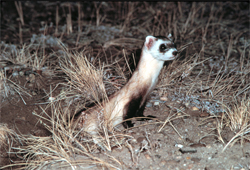 Courtesy of IUCN |
The Black-footed Ferret (Mustela nigripes) from North America is no longer Extinct in the Wild after a massive effort to reintroduce captive animals back to parts of its range. The species is highly dependent on prairie dogs as its food-source; the widespread extermination of prairie dogs throughout the 20th century, and the spread of disease, caused massive declines in the Black-footed Ferret population. In 1985, the species was on the verge of extinction when its last free-ranging population collapsed from an outbreak of canine distemper. Once widespread in central North America, it now exists only in reintroduced populations and is currently listed as Endangered. From 1991 to 2008, a captive breeding programme by the United States Fish and Wildlife Service brought the Black-footed Ferret back to Mexico and eight western states in the US. At present, it is considered self-sustaining at only three locations; two in South Dakota and one in Wyoming.
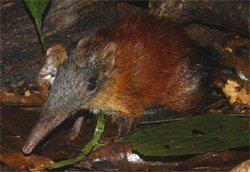 Courtesy of IUCN |
The Grey-Faced Sengi (Rhynchocyon udzungwensis) is a newly discovered species of elephant-shrew from Tanzania. The species is listed as Vulnerable because it is known from only two areas, which are prone to fires caused by drought and by humans from the expanding settlements nearby. It belongs to a group of mammals called Afrotheria that evolved in Africa over 100 million years ago and whose relatives include elephants, sea cows, and the Aardvark. Elephant-shrews get their name because of their long, flexible snouts rather than their genetic relatives. The Grey-faced Sengi was only described this year after being caught on film in 2005 in the remote Ndundulu Forest in Tanzania’s Udzungwa Mountains. It is the first new species of giant elephant-shrew to be discovered in more than 126 years and is over 25 percent larger than any other known sengi. A rapid loss of habitat could quickly push this species into a higher threat category. Although it is found within protected areas, increased human population pressure around the forest edges could have a negative effect on this species. The predicted effects of global climate change will likely further reduce its already fragmented habitat.
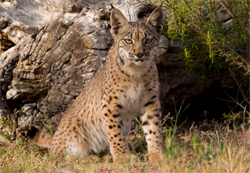 Courtesy of IUCN |
The Iberian Lynx (Lynx pardinus) has a total population of only 84-143 adults, restricted to areas of Spain and Portugal, qualifying the species as Critically Endangered. The continued decline in the Lynx’s population is due in part to the severe depletion of its primary prey, the European Rabbit (Oryctolagus cuniculus). The introduction of Myxomatosis to control rabbits in the 1950s decimated the lynx’s main food source and caused the population to crash. When rabbit recovery seemed possible, viral haemorrhagic pneumonia then struck. In an attempt to maintain Iberian Lynx numbers, conservationists have bred and released rabbits, while the wild population has developed a natural immunity to Myxomatosis. Additional threats to the Iberian Lynx include injuries from snares set for rabbits and accidental deaths from speeding vehicles on the expanding road network. Disease and illegal shooting also threaten the population. The lynx is confined to scattered groups in the southwestern Iberian peninsula where its habitat has been severely fragmented by infrastructure improvement, urban and resort development as well as pine and Eucalyptus plantations.
 Courtesy of IUCN |
The Fishing Cat (Prionailurus viverrinus) has changed category from Vulnerable to Endangered because of the severe decline throughout much of its Asian range over the last decade. It is a medium sized cat and a skilful swimmer, found mainly in wetland habitats such as
swamps, oxbow lakes, reed beds, tidal creeks and mangrove areas. Over 45 per cent of protected wetlands in Southeast Asia are considered threatened, including those that are home to this species. Sites like the estuaries of the Karnataka coast (Southwestern India), and the deltas of the Irrawaddy, Indus, Mekong and Red rivers. Threats to the Fishing Cat include human settlement, draining of its habitat for agriculture, pollution, excessive hunting, wood-cutting and over-fishing.In addition, clearance of coastal mangroves over the past decade has been rapid. The depletion of fish stocks from over-fishing is likely to be a significant threat to this species which relies heavily on fish for its survival.
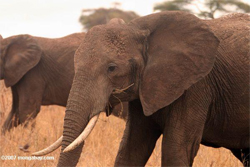 Photo by R. Butler |
The African Elephant (Loxodonta africana) occurs in some 37 countries in sub-Saharan Africa, and are found in dense forest, open and closed savanna, grassland and, at considerably lower densities, even in the arid deserts of Namibia and Mali. Poaching for ivory and meat has traditionally been the major threat to the species. Across the continent, the total population is believed to have suffered a decline of approximately 25% between 1979 and 2007, which falls short of the 30% threshold required for a Vulnerable listing. As such, the African Elephant has been downlisted from the Vulnerable category to Near Threatened. It is believed that the change in status reflects recent and ongoing population increases in major populations in Southern and Eastern Africa, largely due to the implementation of highly successful conservation efforts, and which have been of sufficient magnitude to outweigh any decreases that may be taking place elsewhere across their vast range.
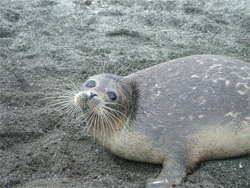 Courtesy of IUCN |
The Caspian Seal (Pusa caspica) has moved from Vulnerable to Endangered. It occurs throughout the Caspian Sea, using the winter ice sheets as a surface on which to give birth and nurse pups. Its population has declined by 90 percent over the last 100 years due to unsustainable levels of commercial hunting, habitat degradation and pollution; it is still decreasing. Since 2005 the number of pups born has plummeted by a catastrophic 60 percent to just 6,000-7,000. A low survival rate among pups has led researchers to fear there are barely enough breeding females to keep the population viable.
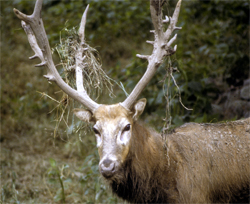 Courtesy of IUCN |
Pere David’s Deer (Elaphurus davidianus) is Extinct in the Wild. Known in Chinese as Milu, their English name is derived from the French missionary Father Armand David. The last wild population is thought to have been eaten by troops during the Boxer Revolution at the turn of the 19th century. They were reintroduced into China in the late 1980s from captive animals bred in Europe; these reintroduced animals have been managed since then and are not considered as wild. The captive population in China has increased in recent years, and the possibility remains that free-ranging populations can be established sometime in the near future. At that point, its IUCN Red List status will need to be reassessed.
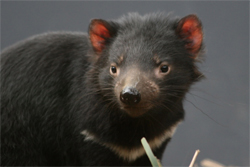 Courtesy of IUCN |
The Tasmanian Devil (Sarcophilus harrisii) is now a threatened species, moving from Least Concern to Endangered. The size of a small dog and found only on the Australian island state of Tasmania, the Devil is the largest carnivorous marsupial in the world. The global population of this species has declined by more than 60 percent over the last 10 years due to a fatal infectious cancer. Devil Facial Tumour Disease (DFTD), is spread amongst Tasmanian Devils through biting and from sharing the same food. Once infected, the animal develops tumours around the mouth, which interferes with feeding and eventually leads to death by starvation.
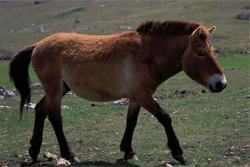 Courtesy of IUCN |
The Wild Horse (Equus ferus) previously was listed as Extinct in the Wild, but as a result of ongoing reintroduction efforts it is now showing signs of improvement and has moved down a category to Critically Endangered. Provided conservation efforts continue and the population continues to improve at its current rate, it may even move into a lower category on its next reassessment. There are currently around 325 free-ranging Wild Horses in Mongolia. The past decline of this species has been attributed to a variety of threats, including hunting, military activities, climatic change, habitat changes and competition with domestic livestock. The main current threat to the reintroduced population is hybridization with and the potential for disease transmission from domestic horses. Habitat degradation and predation by wolves also threaten the population.
Little Earth Hutia (Mesocapromys sanfelipensis), from Cuba, is listed as Critically Endangered (Possibly Extinct); the species has not been seen in nearly 40 years. Hutias are quite large rodents inhabiting the Caribbean Islands. Although 20 species of hutia have been identified, half of them may now be Extinct. Hutias are hunted for food and this, combined with competition from introduced rats and habitat loss from fires may be the reason for the decline and possible loss of the Little Earth Hutia. Recent survey efforts failed to find any remaining individuals, although more surveys are required to confirm whether it still exists or not. If any do still exist, the population would most likely be less than 50 individuals which would not sustain a viable population.
